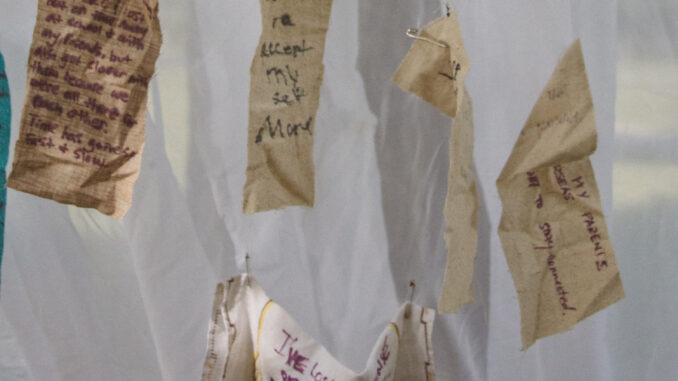
If you’ve walked across Parker Quad between Sept. 3 and Sept. 8, you’ve probably seen the three, 20-foot-tall, glistening white fabric tubes hanging from the trees, decorated with little patterned squares. From afar they look like mysterious portals to the heavens.
If you’ve gone closer you’ve probably seen that the colorful fabric notes were anonymous messages about peoples’ grief and growth due to the pandemic.
And if you walked by at 3 p.m. on Sept. 8 and heard beloved Black Studies Prof. Anthony Dandridge promising, “I don’t have to know you to love you” or Rabbi Lori Wynters sounding the shofar, then you walked by during the memorial ceremony. The ceremony honored those our community has lost since lockdowns began as well as the lessons and joys our community has managed to gain during the world-altering events of 2020, from the pandemic to the election to the civil rights movement.
All week, community members were invited to share how the pandemic has impacted them, for better and for worse, by writing it on a provided piece of fabric and pinning it to the portal.
The exhibit, “Pandemics as Portals: Honoring Loss, Claiming Strength,” was co-sponsored by Rev. Allison Moore, Rabbi Lori Wynters, Sarah Wyman and the Eddy at New Paltz, with contributions from several others. The two services that bookmarked the beginning and the end of the exhibit were filled with music, singing, reflections from the past year and anonymous readings of some of the submissions.
A flyer posted at the exhibit prompted community members to share what some of their experiences were in the past 18 months by thinking deeply about topics that were in the spotlight of 2020: the pandemic, racial injustice, the presidential election, etc. Attendees were encouraged to think about how those topics affected their lives and how they imagined a healthier new normal.
People shared all sorts of truths, from bravely honest to optimistic to devastating. To answer the prompt, “What have you learned?”, one person wrote on a tan fabric, “I’ve learned to be grateful for the time I spend with people and the places I get to go.” To answer the prompt “What would make a healthier community?” one person wrote “Diversity hires.” To answer the prompt “What have you lost?” one person wrote on a soft pink fabric, “My grandma, I would call her on my walks home from class. The last conversation we had on the phone was under this tree.”
Much of this interactive exhibit was inspired by author Arundhati Roy. Roy published an essay in April of 2020 inviting people to see the pandemic as a portal: “Historically, pandemics have forced humans to break with the past and imagine their world anew. This one is no different. It is a portal, a gateway between one world and the next.”
Not only destructive (that’s half of it), the pandemic could also create a space to be imaginative; although it could be scary, the concept of seeing the pandemic as a portal beckons people to look from what once was to what could be.
“My image of a portal is wandering down a tunnel for awhile and seeing the light at the end of the tunnel,” says Rev. Moore, an organizer of the exhibit and the College’s newest chaplain. “But you don’t know if it’s the light from a nuclear holocaust, if it’s the light of a new community, if it’s the light of friends and family. You don’t always know where doors go and I wasn’t sure where the pandemic was going to go.”
The legacy of 2020 won’t be random; it will be the legacy that we choose to build from it. We could build a future rife with racial tensions, or one where anti-racism and accurate historical accounts are included in curriculums.
It could be a future where Native people, Black people and poorer communities continue to have the highest rates of infections and deaths from COVID-19 and other illnesses, or it could be one where the healthcare system is reimagined to correct the scarring of medical racism and to give equal healthcare to all.
It could be a future where the system of policing and incarceration remains violent or one where policing is re-evaluated and community outreach programs are bolstered.
As the pandemic rages on with the Delta and Mu variants and fights for justice continue, so does the time to continue reflecting on what comes next. As organizer Wyman, of the faculty development center, says, “We are still very much in the portal.”
“The tragedy is immediate, real, epic and unfolding before our eyes. But it isn’t new. It is the wreckage of a train that has been careening down the track for years,” Roy writes. She says that now that the engine of capitalism has come to a pause, it’s time to “examine its parts, make an assessment and decide whether we want to help fix it, or look for a better engine.”
“Our minds are still racing back and forth, longing for a return to ‘normality,” trying to stitch our future to our past and refusing to acknowledge the rupture. But the rupture exists. And in the midst of this terrible despair, it offers us a chance to rethink the doomsday machine we have built for ourselves,” she writes. “Nothing could be worse than a return to normality.”
All of the notes that filled the portals on the quad will be transcribed and shared with the public. For those who have ideas on what to do next, the Eddy at New Paltz and the other organizers are curious to hear them. Reach out to Rev. Moore at standrewsrev@gmail.com.

